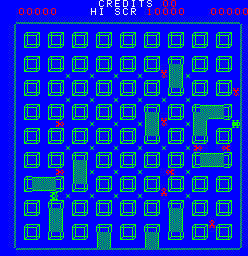Spectar
| Spectar | |
|---|---|
 | |
| Developer(s) | Exidy |
| Publisher(s) | Exidy |
| Designer(s) | Manuel Campos |
| Platform(s) | Arcade, ColecoVision |
| Release | 1980 |
| Genre(s) | Maze |
| Mode(s) | Up to 2 players, alternating |
| Cabinet | Upright |
| Arcade system | Exidy 6502 |
| Display | Raster |
Spectar is an arcade game released by Exidy as a sequel to Targ. The game depicts vehicular combat in a future world. The original game (ROM revision 1) was released in November 1980 and ROM revision 3 in April 1981. ROM revision 2 was for internal use only at Exidy and never installed into any video game cabinet.
Description
Spectar is similar to Targ, but with enhancements. Whereas Targ took place on a completely regular 10x10 grid, Spectar adds blockades to the Crystal City that is the backdrop to the game. In Spectar, the grid is not completely regular. In addition, the center of the grid has a number of twinkling stars that the player can pick up. Clearly inspired by Pac-Man, this introduces a new mechanic to the game: in addition to finishing a level by destroying all enemies, the player can also finish the round by picking up all the dots.
In Targ there were a number of wedge shaped enemies and one "Spectar Smuggler", none of which shot back at you. In Spectar, the enemies, which are called ramjets, change shape every round (and are worth more points for shooting as the levels increase). Five seconds and 10 seconds into each round, a Spectar Smuggler is added, which fires at you. When the first smuggler appears on the board, the background sound changes, until all smugglers have been destroyed.
There is also some graphical glitz in the display of the Crystal City itself. In Targ, the buildings on every level were featureless yellow blocks. In Spectar, each level has a different building design.
The building shapes for each level are:
Level 1: Shaded circle. Level 2: Hollow circle with roughened edges. Level 3: 3D wireframe cubes. Level 4: Solid crucifix. Level 5: Solid diamonds. Level 6: Solid squares crossed with an 'X' shape. Level 7: 3D wireframe pyramids. Level 8: Hollow octagons. Level 9 and subsequent levels: A shape that resembles a space invader with hollowed out section in the centre that looks like a house.
In every level, the building shapes are green and some are randomly joined which restricts the player's and enemies' movements. As each level is completed, a bonus of 1000 times the level number is awarded. The bonus does not further increment after level 9. The score in Spectar resets to zero when 100,000 is surpassed. The high score list and initials resets after every 256 games.
Whereas there was crafty artificial intelligence in the arrow-shaped crafts in Targ making the game very difficult, the enemy in Spectar is much easier to defeat, making Spectar a much easier game to play than its ancestor.
Legacy
There were a number of bootleged versions of Spectar released by Exidy rivals which had identical ROMs except for the title screen game names. The bootlegs were called: Panzer and Phantoms (released by Proel); and Phantomas and Rallys (released by Jeutel and Novar respectively).
In 2006, Scott Huggins wrote an unofficial port of Spectar for the ColecoVision console.
In 2008, H.R. Kaufmann, president of Xidy, released the original ROM images (ROM revisions 1 and 3) for Spectar into the public domain for non-commercial use without payment.[1] Thus Spectar can be now be played for free using an emulator such as MAME.